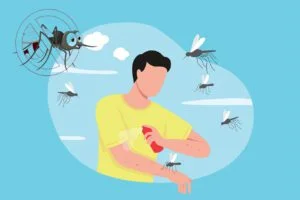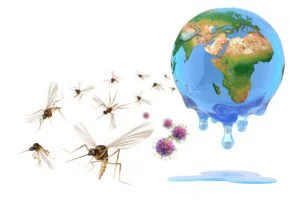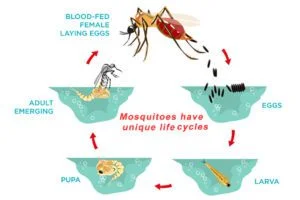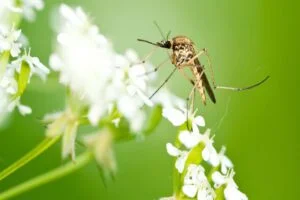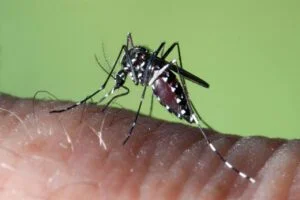Introduction
Fact 1: Mosquitoes have been around for millions of years
Fact 2: Only female mosquitoes bite
Fact 3: Mosquitoes can detect your breath
Fact 4: Mosquitoes have an amazing flying ability
Fact 5: Mosquitoes are attracted to certain smells
Fact 6: Mosquitoes are effective disease vectors
Fact 7: Mosquitoes have unique life cycles
Fact 8: Mosquitoes have different feeding preferences
Fact 9: Mosquitoes are an important part of the ecosystem
Fact 10: Mosquitoes have adapted to survive
Fact 1 Mosquitoes have been around for millions of years
Mosquitoes have been present on Earth for millions of years, meaning they have a long evolutionary history. Fossil evidence indicates that mosquitoes have existed since the Jurassic period, approximately 210 million years ago.The existence of mosquitoes for such extended periods is a testament to their ability to adapt and survive in different environments.
Over time, they have undergone evolutionary changes and developed specific traits that enable them to thrive in different habitats around the world.The longevity of mosquitoes can be attributed to their reproductive capacity and ability to find suitable breeding sites. Female mosquitoes lay their eggs in standing water, such as ponds, swamps, or even small containers. It’s fascinating to think about the vast amount of time that mosquitoes have been a part of Earth’s ecosystem.
Fact 2: Only female mosquitoes bite
Only female mosquitoes bite humans and animals for a blood meal, while male mosquitoes only feed on nectar and plant sap. This behavior is driven by the unique biological requirements of female mosquitoes in their reproductive cycle.The primary reason female mosquitoes bite is to obtain proteins from the blood that are necessary for the development of their eggs. After mating with a male mosquito, the female must acquire these proteins to produce and nourish her offspring.
Blood provides a rich source of protein and other nutrients necessary for egg development.When a female mosquito is ready to lay her eggs, she searches for a suitable host from which she can draw blood. Mosquitoes have special mouthparts, known as proboscis, which they use to pierce the skin and enter blood vessels. They secrete saliva at the bite site, which contains anticoagulant compounds that prevent blood from clotting, allowing them to feed more efficiently.It is important to note that not all female mosquitoes bite humans exclusively.
It’s possible that various mosquito species have varied host preferences.
Different mosquito species may have different preferences for hosts. Some species prefer to feed on birds, reptiles or even other insects.The biting behavior of female mosquitoes can have significant implications for public health. Although male mosquitoes do not bite, female mosquitoes can transmit diseases such as malaria, dengue fever, Zika virus and West Nile virus. When a female mosquito feeds on the blood of an infected person, she can acquire the pathogens responsible for these diseases. Subsequently, if he bites someone else, he can transfer the pathogen and potentially spread the disease.
Fact 3: Mosquitoes can detect your breath
Mosquitoes have a remarkable ability to detect the carbon dioxide (CO2) we exhale in our breath. This unique sensory ability allows them to detect potential hosts for blood meals.
Mosquitoes have specialized receptors called sensilla located on their antennae, which are highly sensitive to CO2. When we exhale, we release a plume of CO2 into the surrounding air. Mosquitoes can detect and follow this plume, which leads them to the source, eg, humans or animals.
The ability to detect CO2 is crucial for female mosquitoes, as they need a blood meal to obtain the proteins necessary for egg development. By detecting our breath, they can identify a suitable host from which they can draw blood. This behavior is particularly important for mosquito species that feed primarily on mammals, including humans.Although CO2 is the primary attractant for mosquitoes, they can also sense other chemical cues associated with our breath.
Compounds such as lactic acid, uric acid, and ammonia, as well as some skin bacteria, contribute to the mosquito’s ability to identify a host. These additional scents act as cues for mosquitoes, helping them locate a suitable blood source.A mosquito’s ability to detect breath is not limited to short distances. They can sense CO2 from several meters away, so they can track the plume and find their target even in complex environments or in the dark.
Fact 4: Mosquitoes have an amazing flying ability
Mosquitoes ability to fly is the result of their unique anatomical features and special adaptations. A major aspect of a mosquito’s ability to fly is its wings. Mosquitoes have long, thin wings designed for efficient and fast flight. These wings are equipped with powerful muscles that allow the mosquito to flap rapidly, generating the lift and thrust necessary for sustained flight.
Unlike many other insects, mosquitoes have a pair of wings that can beat in sync, enabling them to achieve stability and control during flight. This synchronized wing movement allows them to hover, fly forwards, backwards and even move through densely vegetated areas with ease.Mosquitoes also have a high wing-beat frequency, usually 300 to 600 beats per second, depending on the species.This fast wing-beat rate contributes to their agile flight ability, allowing them to quickly change direction and avoid potential threats.
Another interesting aspect of mosquito flight is their ability to fly in different weather conditions. They can navigate in light winds, strong winds and even rain. They accomplish this by adjusting their flight speed and wing angle to compensate for external factors, maintaining stability and control in the air.Mosquitoes also exhibit a remarkable ability to take off and land on different surfaces.
Their legs and feet are equipped with special structures, such as claws and adhesive pads, which enable them to grip various surfaces effectively. This adaptability allows mosquitoes to land on both smooth and rough surfaces, including human skin, plant leaves, and walls.The exceptional flight ability of mosquitoes is not only essential for their survival but also plays an important role in their reproductive behavior. Female mosquitoes, in particular, rely on their flight skills to locate suitable hosts for blood meals and to locate ideal breeding sites.
Fact 5: Mosquitoes are attracted to certain smells
Mosquitoes are attracted to specific odors emitted by their potential hosts, including humans and animals. These odors act as chemical cues that direct the mosquito to a blood meal.A primary odor that attracts mosquitoes is carbon dioxide (CO2). When we exhale, we release CO2 into the air, creating a plume that mosquitoes can detect. Their antennae have special receptors that are highly sensitive to CO2, allowing them to detect the source and follow the scent trail of a potential host.In addition to CO2, mosquitoes are attracted to other chemical compounds found in sweat and body odor.
Lactic acid, which is secreted through sweat, is a compound that mosquitoes find attractive.They can detect even small traces of lactic acid, which acts as a strong attractant for these insects.Uric acid, ammonia and some skin bacteria also contribute to the odor profile that mosquitoes find attractive. These compounds are released through sweat and contribute to the overall odor emitted by the host.
Mosquitoes have receptors that can detect these odors, guiding them to potential blood sources.Additionally, mosquitoes are known to be attracted to various fragrances and scented products. Some perfumes, colognes, soaps and lotions can act as mosquito attractants. It is believed that these scents mimic the odors produced by the hosts and may confuse mosquitoes, which may draw closer to individuals wearing such fragrances.
Fact 6: Mosquitoes are effective disease vectors
Mosquitoes are highly efficient disease carriers, which play an important role in the transmission of various infectious diseases. Their ability to transmit pathogens from one host to another makes them a significant public health concern worldwide.The effectiveness of mosquitoes as disease vectors stems from their unique biology and feeding behavior. Female mosquitoes, in particular, require a blood meal to nourish their eggs and ensure successful reproduction. During their blood-feeding process, they can acquire disease-causing microorganisms from infected hosts.
When a mosquito bites an infected person, pathogens such as viruses, bacteria or parasites enter the mosquito’s bloodstream. These pathogens can replicate and multiply within the mosquito’s body, often migrating to the salivary glands.Once the pathogens reach the salivary glands, they can be injected into a new host during a subsequent blood meal. When an infected mosquito feeds on an uninfected person, it injects its saliva containing the pathogen into the bloodstream of the new host, starting a new infection.Mosquitoes are known to transmit a variety of diseases, including malaria, dengue fever, Zika virus, chikungunya, yellow fever, West Nile virus, and various forms of encephalitis.
The effectiveness of mosquito-borne disease transmission is influenced by several factors. The ability to adapt to different climates and environments further contributes to their efficiency as disease carriers.To combat mosquito-borne diseases, various strategies are employed. These include mosquito control measures such as the use of insecticides, elimination of mosquito breeding sites and development of vaccines. Public education and awareness campaigns play an important role in promoting personal protection measures such as mosquito repellent, wearing protective clothing and sleeping under insecticide-treated bed nets.
Fact 7: Mosquitoes have unique life cycles
Mosquitoes have unique life cycles that consist of four distinct stages: egg, larva, pupa, and adult. Each stage is important to their development and contributes to their ability to thrive in different environments.Eggs: The mosquito life cycle begins with a female mosquito laying eggs. Mosquito eggs are usually laid in standing water or in areas prone to flooding. Eggs may be deposited individually or in clusters, depending on the mosquito species. These eggs are usually resistant to desiccation and can survive in dry conditions until submerged in water.
Larvae: Once mosquito eggs come into contact with water, they develop into larvae. Mosquito larvae spend their time in aquatic and water. They have a distinct head and elongated body with different body parts.
Pupa:
After completing the larval stage, the mosquito enters the pupal stage. At this stage, they do not feed. Pupae have a comma-shaped appearance, their head and thorax forming a distinct shape.
Adult:
Once the metamorphosis is complete, the adult mosquito emerges from the pupal stage. The adult mosquito breaks the surface tension of the water, causing its wings to expand and dry. At this stage, the mosquito is ready to fly and engage in reproductive activity. Female mosquitoes require a blood meal for egg development, while male mosquitoes primarily feed on nectar and plant sap.
Fact 8: Mosquitoes have different feeding preferences
Mosquitoes exhibit diverse food preferences, indicating that not all mosquito species rely solely on human blood for survival and reproduction.Human-biting mosquitoes: Some mosquito species like to bite humans. These mosquitoes, mainly females, seek humans as their primary blood source. These species are of particular concern to human health because they can transmit disease from person to person.
Zoophilic mosquitoes: Other mosquito species exhibit a preference for animals. These mosquitoes primarily feed on the blood of birds, reptiles, mammals or other animals.They may occasionally bite humans, but their primary hosts are non-human species.
Mixed-feeding mosquitoes: Some mosquitoes exhibit mixed feeding habits, meaning they can feed on both humans and animals. These mosquitoes have more flexible feeding behavior and can switch between human and animal hosts depending on availability and environmental conditions.They play an important role in disease transmission.
Nectar-feeding mosquitoes: Male mosquitoes and some female mosquitoes feed exclusively on nectar, plant sap, and other sources of sugar. They do not require a blood meal for egg development and rely mainly on plant nectar to meet their nutritional needs. These mosquitoes play an important role in pollination and plant fertilization.
Fact 9: Mosquitoes are an important part of the ecosystem
Mosquitoes, despite their negative reputation as disease carriers and pests, play an important role in ecosystems as part of food webs and contribute to ecosystem dynamics and
functioning.Food Source:
Mosquitoes serve as an important food source for various organisms. Their larvae, found in water bodies, are eaten by fish, amphibians and other aquatic organisms. Adult mosquitoes are preyed upon by birds, bats, spiders, dragonflies and other insects.Pollination: Some mosquito species, especially nectar-feeding females and males, actively participate in pollination. While feeding on nectar from flowers, they inadvertently transfer pollen from one flower to another, aiding in the pollination process.
Nutrient cycling: Mosquito larvae live in aquatic environments, where they actively consume organic matter and microorganisms. By feeding on decaying plant material, detritus and microorganisms, they help break down and recycle nutrients, contributing to nutrient cycling in aquatic ecosystems.Biodiversity: Mosquitoes are part of the Earth’s immense biodiversity. They are found in a variety of habitats worldwide, from forests and wetlands to urban areas.Their presence and interactions with other organisms contribute to the overall biodiversity of the ecosystem.
Indicator Species:
The presence or absence of certain mosquito species can serve as indicators of environmental conditions and ecosystem health. Some mosquito species have specific habitat requirements and are sensitive to changes in water quality, temperature and other environmental factors.
Fact 10: Mosquitoes have adapted to survive
Mosquitoes have demonstrated remarkable adaptations that enable them to survive and thrive in diverse environments.
Extreme temperature tolerance:
Mosquitoes have a wide range of temperature tolerance, which allows them to survive in different climates. Some species can withstand freezing temperatures by entering a state of diapause or hibernation during the winter. The ability to adapt to extreme temperatures contributes to their global distribution.Finding suitable
breeding sites:
Mosquitoes have adapted to identify and use a wide array of breeding sites for their larvae. While some species lay eggs in freshwater resources such as ponds and marshes, others may breed in temporary water sources such as rainwater-filled containers or even tree holes.
Feeding strategy: Female mosquitoes have developed specialized mouthparts including proboscis, which enable them to pierce the host’s skin and feed on blood. The saliva they inject during feeding contains anticoagulant compounds that prevent blood clotting, ensuring continuous blood flow. These adaptations allow the egg to obtain the nutrients it needs to develop and avoid detection and expulsion by the host’s immune system.
Predator Avoidance:
Mosquitoes have evolved various mechanisms to avoid predators. Their small size, agility in flight and ability to hide in trees or other shelter make them difficult for predators to catch.
Fast reproduction and high production:
Mosquitoes have developed a reproductive strategy that ensures high population growth. Female mosquitoes can lay large numbers of eggs during each oviposition, with some species capable of producing hundreds of eggs at once.
Resistance to pathogens:
Mosquitoes have developed some level of resistance to certain pathogens. For example, some species of mosquito can carry and transmit diseases such as malaria without being adversely affected by the pathogen.
Are Mosquitoes Ruining Your Outdoor Fun? Try These Top-Rated Solutions!





